The Morro Bay estuary is an important habitat for a wide variety of life, ranging from microscopic phytoplankton to apex predators such as sharks. When species in the estuary decline in numbers, it can upset the balance of the ecosystem and trigger a chain reaction for more species loss.

There are nearly a hundred species listed as currently endangered in the Atlas of Sensitive Species of the Morro Bay Area. Sensitive species are those requiring special management consideration to promote their conservation and reduce the likelihood that they will become endangered. Some of these species have stabilized or rebounded thanks to conservation efforts, but some remain at risk and a few are even thought to be extinct. This post will discuss three sensitive species in the estuary, their history, and their current status.
Southern Sea Otter – Enhydra lutris nereis
Sea otters are one of the most recognizable species here in Morro Bay. Rafts of otters are frequently spotted around the estuary, making them a very popular attraction for locals and tourists alike. From a historic population of about 16,000 individuals throughout the North Pacific Ocean, they faced decimation and presumed extinction in the 1800’s due to the fur trade. In 1938, a single colony of about 50 otters was discovered near Bixby Creek, about 15 miles south of Carmel, CA. Their population has since grown to approximately 3,000 individuals between Half Moon Bay and Point Conception.
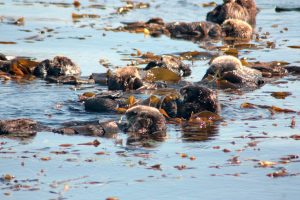
Southern sea otters still face many threats to population stability. They are at risk of poisoning by biotoxins from harmful algal blooms, which can become concentrated in the tissues of the shellfish that are a staple of their diet. Otters are also very susceptible to oil spills, as oil reduces the ability of their fur to hold air and keep them warm, leading to hypothermia and death.
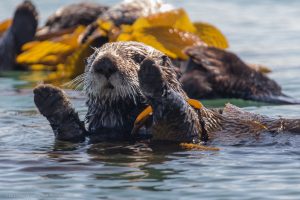
Southern sea otters are still considered endangered and are protected under the Endangered Species and Marine Mammal Protection Acts. Unfortunately, their population has declined in some areas since 2015 due to increased disease and predation. To learn more about sea otters and how to protect them when recreating in the Morro Bay estuary, visit seaottersavvy.org.
Coastal Rainbow Trout/Steelhead – Oncorhynchus mykiss irideus
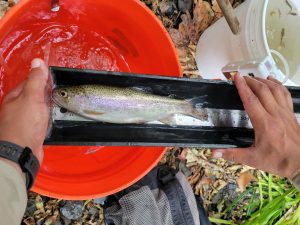
Oncorhynchus mykiss are found natively in freshwater streams along the coast of Western North America and Pacific Asia. Those that spend their entire lives in fresh water are called rainbow trout. Others, though they are genetically identical, hatch in freshwater creeks, migrate to the ocean to grow to adulthood, and then return to our creeks to reproduce. These fish are anadromous (moving from fresh water to the ocean and back throughout a lifetime) and are known as steelhead.
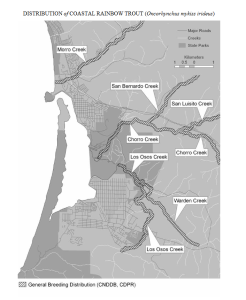
Steelhead face many threats to their population in the watershed, most notably habitat loss. Contamination such as increased sedimentation from runoff impacts steelhead habitat. Steelhead are also at risk due to climate change, as water temperatures increase and the amount of water in streams decreases. In some cases, steelhead are unable to reach their spawning grounds due to low water levels.
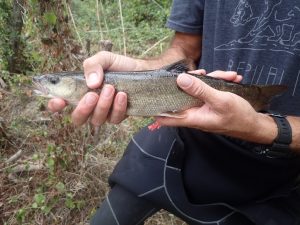
US Fish and Wildlife lists steelhead as a threatened species, and many conservation efforts are underway to protect them. The Estuary Program conducts steelhead monitoring and restoration projects throughout the watershed with partners such as the Watershed Stewards Program, the Coastal San Luis Resource Conservation District, Army National Guard Base Camp San Luis Obispo, and SLO County.
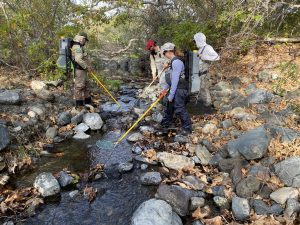
Morro Bay Kangaroo Rat – Dipodomys heermanni morroensis
Unfortunately not all efforts to protect endangered species are successful. This is the case with the Morro Bay kangaroo rat.
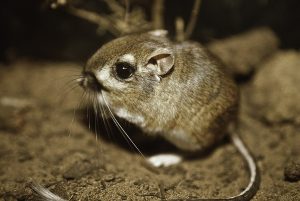
The kangaroo rat population declined throughout the 20th century, from 8,000 individuals in 1957 to fewer than 50 in 2000. It was declared endangered in 1970. There have been several attempts at captive breeding and crossbreeding programs, none of which have proven successful.
As kangaroo rats can only survive in undisturbed sandy areas, population decline is mostly due to habitat loss and degradation related to residential development and habitat fragmentation. Predation from domestic animals such as cats may have also contributed to their decline.
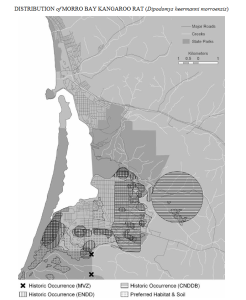
A Morro Bay kangaroo rat has not been captured in the wild since 1986. Parts of their historical range are located on private property, which makes it difficult to conduct trapping or other projects to determine their presence. In 2011, potential signs of kangaroo rat presence were detected at historical sites, which indicates that they may be surviving in very low numbers.
What Can You Do?
There are many things you can do to help protect sensitive species in the Morro Bay watershed and beyond.
Be conscious of your actions that can affect nearby waterways. Avoid over-application of herbicides and fertilizer in your yard. These chemicals can seep into the groundwater or be carried to a nearby creek by storm flows, impacting sensitive species. Help protect habitats by staying on the trails and keeping your dog on a leash. When out in nature, practice responsible wildlife viewing. If in a kayak, stay 50 feet from wildlife. Pick up pet waste and dispose of it properly in the trash.
Learn about organizations in your area that are working on habitat restoration, and volunteer or donate.
References
Kofron, Christopher P., and Francis X. Villablanca. “Decline of the Endangered Morro Bay Kangaroo Rat in California.” Journal of Fish and Wildlife Management 7, no. 1 (2016): 237-254. https://doi.org/10.3996/102014-JFWM-078.
“Morro Bay Kangaroo Rat (Dipodomys Heermanni Morroensis).” U.S. Fish & Wildlife Service Environmental Conservation Online System. https://ecos.fws.gov/ecp/species/6367.
Sims, Aaron E. 2010. Atlas of Sensitive Species of the Morro Bay Area. Lulu Enterprises, Inc. https://www.mbnep.org/wp-content/uploads/2014/12/Atlas_Sensitive_Species_of_Morro_Bay_Area.pdf.
“South-Central California Coast Steelhead.” NOAA Fisheries. https://www.fisheries.noaa.gov/west-coast/endangered-species-conservation/south-central-california-coast-steelhead.
“Southern Sea Otter.” Marine Mammal Commission. November 18, 2015. https://www.mmc.gov/priority-topics/species-of-concern/southern-sea-otter/.
“Southern Sea Otter.” U.S. Fish & Wildlife Service. https://www.fws.gov/species/southern-sea-otter-enhydra-lutris-nereis.
“State of the Bay 2023.” Morro Bay National Estuary Program. https://library.mbnep.org/wp-content/uploads/2023/02/MB_State-of-the-Bay-2023.pdf.
“Steelhead Trout.” NOAA Fisheries. https://www.fisheries.noaa.gov/species/steelhead-trout.
“What’s Killing Sea Otters? Scientists Pinpoint Parasite Strain.” UC Davis. August 22, 2019. https://www.ucdavis.edu/news/whats-killing-sea-otters-scientists-pinpoint-parasite-strain.
Help us protect and restore the Morro Bay estuary!
- Donate to the Estuary Program today and support our work in the field, the lab, and beyond.
The Estuary Program is a 501(c)3 nonprofit. We depend on funding from grants and generous donors to continue our work. - Support us by purchasing estuary-themed gear from ESTERO. This locally owned and operated company donates 20% of proceeds from its Estuary clothing line and 100% of Estuary decal proceeds to the Estuary Program. Thank you, ESTERO!
- Purchase items from the Estuary Program’s store on Zazzle. Zazzle prints and ships your items, and the Estuary Program receives 10% of the proceeds. Choose from mugs, hats, t-shirts, and even fanny packs (they’re back!) with our fun Estuary Octopus design, our classic Estuary Program logo, or our Mutts for the Bay logo.
Thank you for helping our beautiful, bountiful, biodiverse bay!